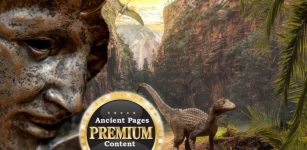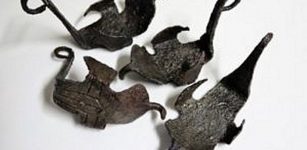Unraveling Pharaohs’ True Knowledge Of Hieroglyphs – Could All Pharaohs Read And Write?
Ellen Lloyd - AncientPages.com - Magnificent ancient Egyptian tombs covered with mysterious hieroglyphs telling incredible stories of the Pharaohs and the rise and fall of great dynasties captivate archaeologists, historians, and the public alike. It is only relatively recently that modern science has learned more about the secrets written on the walls of ancient Egyptian tombs.
Credit: Adobe Stock - merydolla
Deciphering Egyptian Hieroglyphs
On July 15, 1799, the Rosetta Stone was found in the Egyptian village of Rosetta (today called "Rashid") by French Captain Pierre-François Bouchard during Napoleon's Egyptian Campaign.
The Rosetta Stone is an essential historical document that allowed modern scientists to understand Egyptian hieroglyphs.
Jean-François Champollion broke the code of the hieroglyphs, and by doing so, he opened a new door to our exploration of ancient Egyptian history.
"On September 14, 1822, Champollion was working alone in his Paris home, poring over texts copied from the Great Temple of Abu Simbel.
To his great surprise, he found that he could decipher the royal name 'Ramesses' embedded in the text. Running to his brother's office he burst through the door, shouted 'Je tiens l'affaire!'
('I've got it!'), and dropped to the floor in a faint. Ten years later, suffering from consumption, diabetes, gout, paralysis, heart, kidney and liver disease, Champollion died, apparently of a stroke. He was just 41 years old." 1
Ancient Egyptians Beliefs In The Afterlife
When admiring magnificent tombs in the land of the Pharaohs, we tend to forget that most people in ancient Egypt could never afford to receive a proper burial, and the journey to the afterlife was anything but glorious when the deceased's body was placed in a simple grave.
Ancient Egyptians did not treat death as the end of one's existence. Death was regarded as a transition to another reality. Those who were rich had the means to prepare before entering the realms of the afterlife, but the poor ones could do little.
Historians have determined that Pyramid Texts represent the oldest known collection of ancient Egyptian hieroglyphic inscriptions.
The Pyramid Texts contained elaborate spells, hymns, prayers, funerary rites, and anything significant and needed to chart the Pharaohs into the journey of the afterlife.
Pyramid Texts were magical rather than religious, discovered on several ancient tombs' walls.
"The texts were meticulously recorded on the walls of the pyramids of the kings Unas of the 5th Dynasty and Teti, Pepi I, Merenre, and Pepi II of the 6th Dynasty.
All these rulers of Egypt from 2400 BC to 2200 BC were buried at Saqqara, the ancient necropolis of Memphis.
At first, the texts were intended to protect a dead king or queen and ensure life and sustenance in the afterlife. By the end of the Old Kingdom, specific chapters of the texts were used in non-royal tombs belonging to regional governors and other men of high status." 2
Knowledge Of Hieroglyphs Among Pharaohs, Priests And Ordinary People
Considering the many written stories in ancient Egyptian tombs, one cannot help wondering If all Pharaohs could read and write the hieroglyphs.
In ancient Egypt, hieroglyphs were called "the words of God," They were used mainly by priests with vast knowledge in various subjects.
Egyptian Pharaohs were considered to be both divine deities as well as mortal rulers.
The Pharaohs were powerful beings whom ordinary people worshiped, and today, we find their names carved in stone on the walls of temples and tombs.
According to the British Museum, "the ancient Egyptians used writing to communicate information about a person shown on a sculpture or relief.
They called their writing 'divine word' because they believed that Thoth, god of wisdom, had taught them how to write.
The word hieroglyphs derives from a phrase meaning 'sacred carvings' used by the ancient Greek visitors to Egypt to describe the symbols they saw on tomb and temple walls.
The Edfu Temple's walls are covered with ancient inscriptions. Credit: Adobe Stock - olab214
The number of hieroglyphic signs gradually grew to over 7000 in total, though not all of them were used on a regular basis. The hieroglyphs were chosen from various observed images, such as people, birds, trees, or buildings. Some represent the sounds of the ancient Egyptian language, but consonants only." 3
Scientists have researched peoples' ability to read and write in ancient Egypt. Based on the findings, the researchers concluded that only 1-3 percent of the inhabitants of ancient Egypt could read and write. It is also essential to add that very few Egyptian written sources reveal something about the literacy of the kings of Egypt.
Dr. Filip Taterka at the Institute of Mediterranean and Oriental Cultures of the Polish Academy of Sciences, states that "relatively late sources suggest that even one of the first rulers of Egypt - Aha - mastered the writing skill. He was believed to be an author of a few medical treaties, although the reliability of this report is, of course, debatable." 4
According to an article published by PAP - Science and Scholarship in Poland, "the oldest source directly referring to pharaonic literacy comes from the end of the Fifth Dynasty, the end of the 3d millennium BC. Royal dignitary Inti an inscription carved inside his tomb at Saqqara near the oldest pyramid in the world, which mentions receiving a letter personally written by Pharaoh Isesi.
The researcher found numerous allusions to skills in writing by the rulers of the land of the Nile in the Texts of the Pyramids, the oldest religious inscriptions carved inside the 10 pyramids.
"The most famous Egyptian text that speaks of the royal literacy is the Prophecy of Neferti. It is a story concerning the first king of the fourth dynasty - Sneferu.
In the story, the ruler writes down the words of Neferti - the wise man from the East- on papyrus. Although this story can not be treated as proof of literacy of Sneferu himself, since it was created a thousand years after his reign, it clearly shows that at least in the time of the 12th dynasty, the Egyptians could imagine such a situation," believes Taterka.
Evidence of the Pharaoh's literacy is - according to the Egyptologist - rich clerical equipment found by Howard Carter in the tomb of Tutankhamun in the Valley of the Kings, which, according to the discoverer, bears traces of use, dating back to the period of education of the young king.
Egyptologists say that future pharaohs often held high administrative positions. Any function within the state administration in ancient Egypt was associated with the absolute necessity of knowing the letter. Without this, they would not be able to perform their duties.
Unfortunately, little is known about the education of royal children. However, historical and archaeological data reveal with certainty that in the time of the pyramids' builders, a unique institution was set up for this purpose at the royal court. From the time of Queen Hatshepsut (15th century BC), royal educators are known, although we do not know the exact list of their duties.
Knowledge of hieroglyphics was necessary to fulfill the Pharaoh's royal duties, which included religious rituals during which the ruler would recite sacred texts. The ruler was the only intermediary between gods and humans. He was often identified with the god Thoth, the inventor of the hieroglyphs.
It turns out that not all pharaohs spoke the language of Egypt and could write in it. In the 1st millennium BC, Egypt was often under a foreign reign.
"Persian, Greek, and Roman rulers in the official presentations were portrayed in the Egyptian manner, but most of them did not have the knowledge of the language, not to mention hieroglyphs," - believes Taterka.
Statue of Pharaoh Khafre at the Egyptian Museum. Credit: Einsamer Schütze, CC BY-SA 3.0
According to his research, however, most pharaohs knew the art of reading and writing. These skills were uncommon in nearby Mesopotamia.
"Peers of Egyptian rulers, kings, and princes of Mesopotamia, basically did not have a command of cuneiform, probably due to the fact that it was far more difficult to master, but there were exceptions," - concluded the Egyptologist."
As time passed, Pagan monuments and inscriptions were destroyed in Egypt. "The language passed from the knowledge of men, and the hieroglyphs became a source of wild speculation and mystical theorizing. The wisdom of Egypt would become a legend, but its learning was lost beneath the weight of twenty centuries of dust and ignorance." 5
Today, with the help of science and archaeology, we have slowly but successfully preserved ancient Egypt's wisdom and recorded it for future generations, ensuring the history of events and people long gone will never be lost again.
Updated on August 21, 2023
Written by - Ellen Lloyd – AncientPages.com
Copyright © AncientPages.com All rights reserved. This material may not be published, broadcast, rewritten or redistributed in whole or part without the express written permission of AncientPages.com
Expand for references- Jean-Francois Champollion - My Journey To Egypt
- Sutherland - Pyramid Texts Of Ancient Egypt That Charted Journey Of Pharaohs Into Afterlife, AncientPages.com
- The British Museum - Ancient Egypt: Symbols of the Pharaoh
- Science in Poland - Did The Pharaohs Know Hieroglyphic Writing? - Polish Egyptologist Explains
- Barbara Mertz - Temples, Tombs, and Hieroglyphs: A Popular History of Ancient Egypt
More From Ancient Pages
-
 The Word Freelancer Originates From Medieval Mercenary Knights
Ancient History Facts | Feb 25, 2016
The Word Freelancer Originates From Medieval Mercenary Knights
Ancient History Facts | Feb 25, 2016 -
 New Type Of Early Previously Unknown Human Discovered In Israel
Archaeology | Jun 29, 2021
New Type Of Early Previously Unknown Human Discovered In Israel
Archaeology | Jun 29, 2021 -
 Mystery Of The Anglo-Saxon Harpole Burial Continues – New Clues
Archaeology | Dec 14, 2023
Mystery Of The Anglo-Saxon Harpole Burial Continues – New Clues
Archaeology | Dec 14, 2023 -
 Strange Story Of The Viking Who Mysteriously Vanished And Ended Up In America By Mistake – He Was Not Happy About It!
Vikings | Jan 7, 2025
Strange Story Of The Viking Who Mysteriously Vanished And Ended Up In America By Mistake – He Was Not Happy About It!
Vikings | Jan 7, 2025 -
 Afterlife: Ancient Egyptian Mummification Balms Studied
Archaeology | Aug 31, 2023
Afterlife: Ancient Egyptian Mummification Balms Studied
Archaeology | Aug 31, 2023 -
 The Carthaginians’ Secret: Mysterious Desert Land Or America Found By Mistake?
Ancient Mysteries | Jul 27, 2017
The Carthaginians’ Secret: Mysterious Desert Land Or America Found By Mistake?
Ancient Mysteries | Jul 27, 2017 -
 Puzzling Ancient Artifacts Found In Canadian Mountains Defy Explanation – Scientists Say
Featured Stories | Aug 27, 2024
Puzzling Ancient Artifacts Found In Canadian Mountains Defy Explanation – Scientists Say
Featured Stories | Aug 27, 2024 -
 Mystery Of The Lost Anglo-Saxon Queen Cynethryth May Soon Be Solved By Archaeologists
Archaeology | Aug 2, 2022
Mystery Of The Lost Anglo-Saxon Queen Cynethryth May Soon Be Solved By Archaeologists
Archaeology | Aug 2, 2022 -
 Legendary And Mysterious Stone Of Brutus – The London Stone Refuses To Give Up Its Secrets
Artifacts | Jan 21, 2022
Legendary And Mysterious Stone Of Brutus – The London Stone Refuses To Give Up Its Secrets
Artifacts | Jan 21, 2022 -
 LIDAR Technology Reveals Secrets Of Ancient Maya Civilization
Archaeology | Feb 3, 2018
LIDAR Technology Reveals Secrets Of Ancient Maya Civilization
Archaeology | Feb 3, 2018 -
 Bellerophon: Great Hero Of Homer’s Iliad Who Was Punished By Gods For His Pride And Arrogance
Featured Stories | Jul 13, 2021
Bellerophon: Great Hero Of Homer’s Iliad Who Was Punished By Gods For His Pride And Arrogance
Featured Stories | Jul 13, 2021 -
 Extraordinary Find: Monumental Relief Of King Ashurbanipal And Deities Unearthed In Ancient City Of Nineveh
Archaeology | May 14, 2025
Extraordinary Find: Monumental Relief Of King Ashurbanipal And Deities Unearthed In Ancient City Of Nineveh
Archaeology | May 14, 2025 -
 Magnificent 2,000-Year-Old Marble Head Of God Dionysus Discovered In Rome
Archaeology | Jun 17, 2019
Magnificent 2,000-Year-Old Marble Head Of God Dionysus Discovered In Rome
Archaeology | Jun 17, 2019 -
 “The Starving Of Saqqara Statue” And Its Undeciphered Inscription Could Pre-Date The Pyramids Of Egypt
Archaeology | Jun 2, 2014
“The Starving Of Saqqara Statue” And Its Undeciphered Inscription Could Pre-Date The Pyramids Of Egypt
Archaeology | Jun 2, 2014 -
 ‘Impossible’ Ancient Traces Of Humans – No, We Are Not The First
Ancient Mysteries | May 16, 2020
‘Impossible’ Ancient Traces Of Humans – No, We Are Not The First
Ancient Mysteries | May 16, 2020 -
 Thousand-Year-Old Sarcophagus Discovered In Odense
News | Sep 28, 2015
Thousand-Year-Old Sarcophagus Discovered In Odense
News | Sep 28, 2015 -
 Remarkable ‘Hipposandals’ Found At Vindolanda
Archaeology | Aug 18, 2018
Remarkable ‘Hipposandals’ Found At Vindolanda
Archaeology | Aug 18, 2018 -
 Prehistoric Humans Adapted To Intense Climate Change – New Study
Archaeology | Apr 22, 2022
Prehistoric Humans Adapted To Intense Climate Change – New Study
Archaeology | Apr 22, 2022 -
 Biblical Mosaic Depicting Miracles Of Jesus Discovered At The ‘Burnt Church’ In Hippos
Archaeology | Sep 24, 2019
Biblical Mosaic Depicting Miracles Of Jesus Discovered At The ‘Burnt Church’ In Hippos
Archaeology | Sep 24, 2019 -
 Unexplained Ancient Wars In America – Knowledge Of Ancient High-Tech Weapons? – Part 1
Ancient Mysteries | Sep 29, 2020
Unexplained Ancient Wars In America – Knowledge Of Ancient High-Tech Weapons? – Part 1
Ancient Mysteries | Sep 29, 2020



